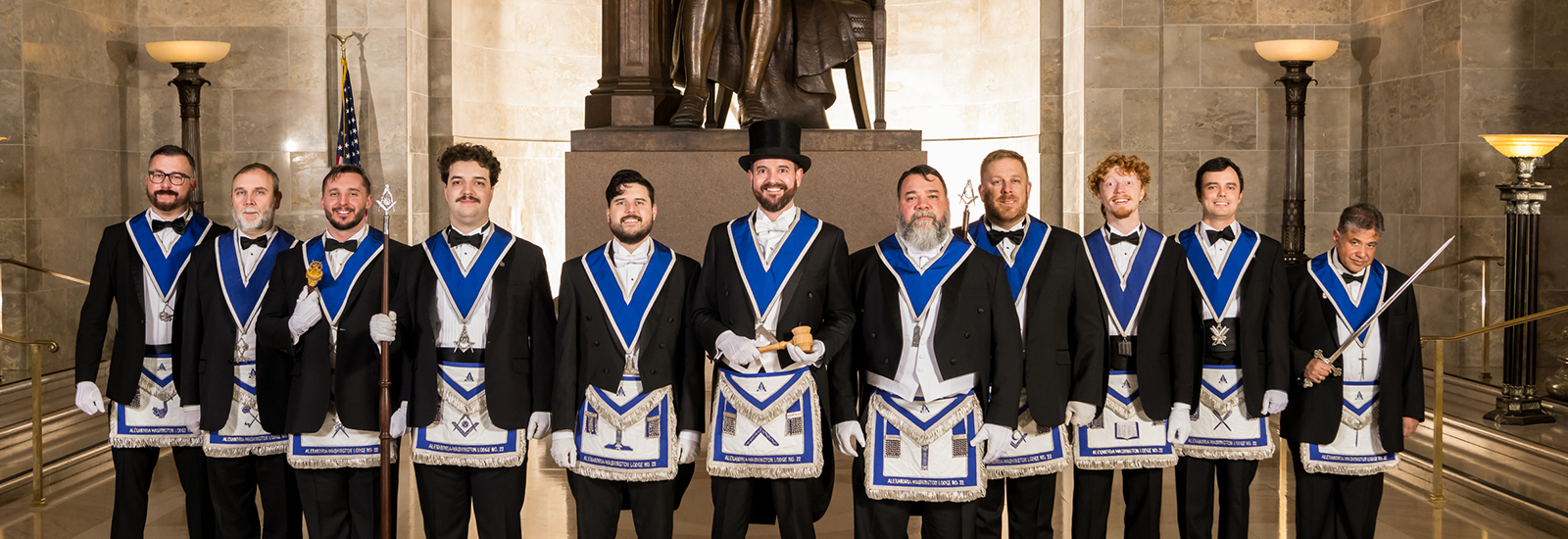Lodge Charters (1783-Present)
Lodge No. 39 (1783-1788)
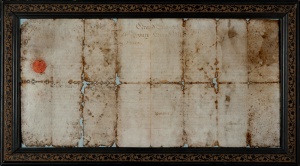 Founded in the waning days of the American Revolution, the birth of our lodge began in 1782 when Robert Adam, Esq., Col. Michael Ryan, William Hunter, Sr., John Allison, Peter Dow and Dr. Elisha Cullen Dick presented a petition to the Grand Lodge of Pennsylvania requesting a warrant to open a Masonic lodge in Alexandria. Lodge No. 39 at Alexandria, Virginia was warranted by the Provincial Grand Lodge of Pennsylvania (Ancient) on February 3, 1783 and was constituted on the 25th of that month, installing Worshipful Robert Adam, Esq., Master; Col. Michael Ryan, Senior Warden; and William Hunter, Junior Warden. Dr. Elisha Cullen Dick was installed as Secretary. The lodge has been in continuous existence ever since that date, making it the first lodge in the City of Alexandria and one of the oldest lodges in the Commonwealth of Virginia.
Founded in the waning days of the American Revolution, the birth of our lodge began in 1782 when Robert Adam, Esq., Col. Michael Ryan, William Hunter, Sr., John Allison, Peter Dow and Dr. Elisha Cullen Dick presented a petition to the Grand Lodge of Pennsylvania requesting a warrant to open a Masonic lodge in Alexandria. Lodge No. 39 at Alexandria, Virginia was warranted by the Provincial Grand Lodge of Pennsylvania (Ancient) on February 3, 1783 and was constituted on the 25th of that month, installing Worshipful Robert Adam, Esq., Master; Col. Michael Ryan, Senior Warden; and William Hunter, Junior Warden. Dr. Elisha Cullen Dick was installed as Secretary. The lodge has been in continuous existence ever since that date, making it the first lodge in the City of Alexandria and one of the oldest lodges in the Commonwealth of Virginia.
Alexandria Lodge No. 22 (1788-1805)
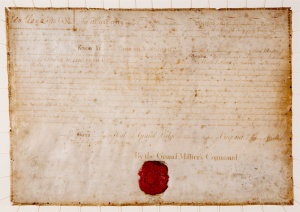 On October 13, 1788, the Lodge requested to withdraw from Pennsylvania obedience and soon thereafter petitioned for a charter from the Grand Lodge of Virginia, based in Richmond, “to which we may conveniently send representatives [and] will be more natural than our present situation.” Having obtained his personal consent for the use of his name, the Virginia petition expressed “the earnest desire of the members of this Lodge that our Brother GEORGE WASHINGTON, Esq., shall be named in the charter as Master of the Lodge.” At the next regular Communication on April 28, 1788, Virginia Governor and Grand Master of Masons Edmond Randolph ordered Alexandria Lodge No. 22 chartered under the Grand Lodge of Virginia, with George Washington as Master. Washington was the Master of the Lodge when he was inaugurated as the first President of the United States on April 4, 1789.
On October 13, 1788, the Lodge requested to withdraw from Pennsylvania obedience and soon thereafter petitioned for a charter from the Grand Lodge of Virginia, based in Richmond, “to which we may conveniently send representatives [and] will be more natural than our present situation.” Having obtained his personal consent for the use of his name, the Virginia petition expressed “the earnest desire of the members of this Lodge that our Brother GEORGE WASHINGTON, Esq., shall be named in the charter as Master of the Lodge.” At the next regular Communication on April 28, 1788, Virginia Governor and Grand Master of Masons Edmond Randolph ordered Alexandria Lodge No. 22 chartered under the Grand Lodge of Virginia, with George Washington as Master. Washington was the Master of the Lodge when he was inaugurated as the first President of the United States on April 4, 1789.
Alexandria-Washington Lodge, No. 22 (1805-Present)
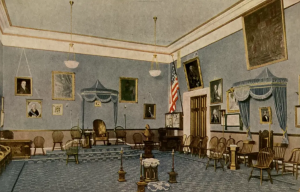 Following George Washington’s death on December 14, 1799, the lodge wished to honor our Charter Master in perpetuity and in 1804, adopted a resolution requesting that its name be changed to the Alexandria Washington Lodge, No. 22. The Grand Lodge acceded to the request, initially conditioned upon the surrender of the 1788 charter and the issuance of a new one. The lodge objected, not desiring to lose its original Virginia charter in which Washington was named Master. Understanding the desire to preserve an irreplaceable piece of American and Masonic history, on December 17, 1805, the Grand Lodge of Virginia adopted a resolution permitting the change of name with retention of the old charter.
Following George Washington’s death on December 14, 1799, the lodge wished to honor our Charter Master in perpetuity and in 1804, adopted a resolution requesting that its name be changed to the Alexandria Washington Lodge, No. 22. The Grand Lodge acceded to the request, initially conditioned upon the surrender of the 1788 charter and the issuance of a new one. The lodge objected, not desiring to lose its original Virginia charter in which Washington was named Master. Understanding the desire to preserve an irreplaceable piece of American and Masonic history, on December 17, 1805, the Grand Lodge of Virginia adopted a resolution permitting the change of name with retention of the old charter.
Meeting Locations (1783 – Present)
Taverns and Private Homes (1783-1802)
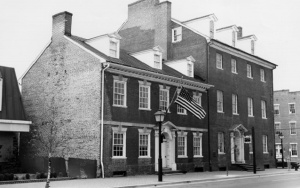 From 1783-1802, as was common practice for many Masonic lodges of the time, meetings were held in a rotating series of taverns and private homes around Alexandria. Early meeting locations included John Wise’s Tavern (later known as Gadsby’s Tavern, a National Historic Landmark). In addition to serving as an early home and place for refreshment for our lodge, the tavern was a hub of social and political life in Alexandria during the early days of our nation. A meeting convened there by George Washington laid the foundation for the Constitutional Convention in Philadelphia, and the first celebration following the adoption of a Federal Constitution was held at the tavern in 1788. In addition to George Washington, prominent Freemasons known to have enjoyed the tavern’s hospitality (and perhaps some fellowship with Alexandria Lodge) include founding fathers George Clinton and Benjamin Franklin. As early as 1785, however, as the bustling port city continued to grow some of these locations were found to be less than ideal, with some described as “a public resort for strangers and travelers, and not sufficiently secure from intrusion.” The need for a permanent meeting space became increasingly apparent.
From 1783-1802, as was common practice for many Masonic lodges of the time, meetings were held in a rotating series of taverns and private homes around Alexandria. Early meeting locations included John Wise’s Tavern (later known as Gadsby’s Tavern, a National Historic Landmark). In addition to serving as an early home and place for refreshment for our lodge, the tavern was a hub of social and political life in Alexandria during the early days of our nation. A meeting convened there by George Washington laid the foundation for the Constitutional Convention in Philadelphia, and the first celebration following the adoption of a Federal Constitution was held at the tavern in 1788. In addition to George Washington, prominent Freemasons known to have enjoyed the tavern’s hospitality (and perhaps some fellowship with Alexandria Lodge) include founding fathers George Clinton and Benjamin Franklin. As early as 1785, however, as the bustling port city continued to grow some of these locations were found to be less than ideal, with some described as “a public resort for strangers and travelers, and not sufficiently secure from intrusion.” The need for a permanent meeting space became increasingly apparent.
Market Hall (1802-1945)
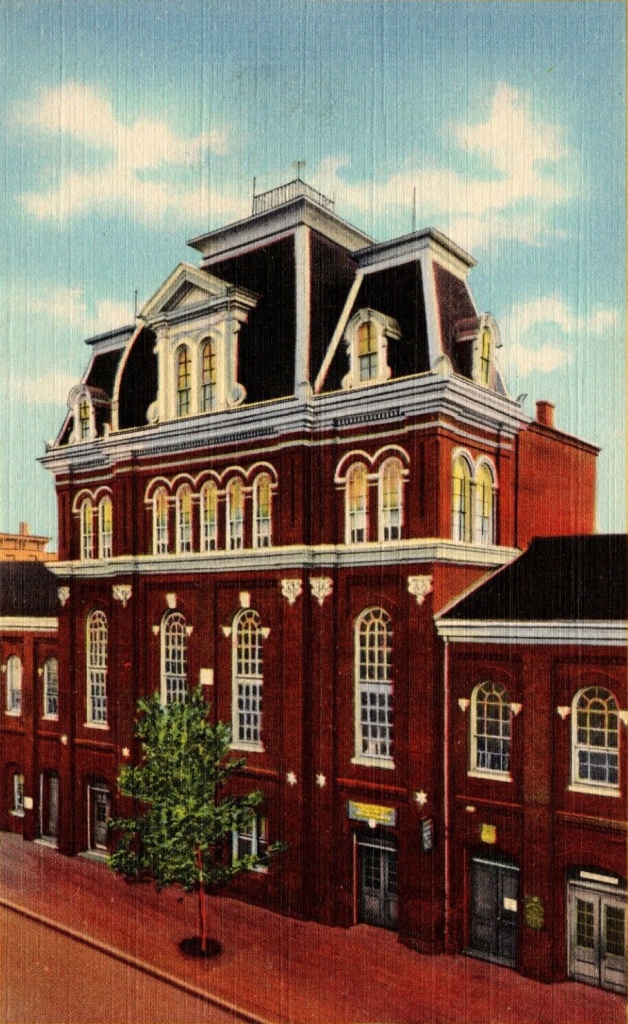 In 1802, at the then-cost of $1988, a “well arranged Hall, with anterooms” was constructed above the market building and courthouse, with the first meeting held there on September 16 of that year. It was at this location that the lodge welcomed many distinguished guests for nearly 70 years, including the Marquis de Lafayette in 1825, on which occasion he was elected a member and presented the lodge with a key to the Bastille, the notorious Parisian prison toppled during the French Revolution. On the night of May 19, 1871, a fire broke out which ultimately destroyed the entire market building. Much of the lodge furniture and a number of items in the archives were lost to the conflagration, though the lodge records, an original William Williams portrait of Washington in Masonic regalia (widely considered the most accurate depiction of him in later life) and the Master’s chair used by our illustrious brother in 1788 were miraculously saved and remain in the lodge’s possession to this day. The hall was rebuilt together with City Hall and served as its home until the lodge moved to its present quarters in the George Washington Masonic National Memorial in 1945. Reminders of the historic building serving as a welcoming host of Alexandria-Washington Lodge for nearly a century and a half, the events that forever altered our lodge history and the unbreakable ties between the lodge and the city can still be seen today. On the northern facade of the building, the familiar square & compasses adorn the marble keystones framing the large center windows, and embedded into the exterior wall is a white marble plaque reading, “Alexandria Washington Lodge No. 22, Chartered A.D. 1788, Destroyed by fire May 19, A.D. 1871, Rebuilt A.D. 1874.”
In 1802, at the then-cost of $1988, a “well arranged Hall, with anterooms” was constructed above the market building and courthouse, with the first meeting held there on September 16 of that year. It was at this location that the lodge welcomed many distinguished guests for nearly 70 years, including the Marquis de Lafayette in 1825, on which occasion he was elected a member and presented the lodge with a key to the Bastille, the notorious Parisian prison toppled during the French Revolution. On the night of May 19, 1871, a fire broke out which ultimately destroyed the entire market building. Much of the lodge furniture and a number of items in the archives were lost to the conflagration, though the lodge records, an original William Williams portrait of Washington in Masonic regalia (widely considered the most accurate depiction of him in later life) and the Master’s chair used by our illustrious brother in 1788 were miraculously saved and remain in the lodge’s possession to this day. The hall was rebuilt together with City Hall and served as its home until the lodge moved to its present quarters in the George Washington Masonic National Memorial in 1945. Reminders of the historic building serving as a welcoming host of Alexandria-Washington Lodge for nearly a century and a half, the events that forever altered our lodge history and the unbreakable ties between the lodge and the city can still be seen today. On the northern facade of the building, the familiar square & compasses adorn the marble keystones framing the large center windows, and embedded into the exterior wall is a white marble plaque reading, “Alexandria Washington Lodge No. 22, Chartered A.D. 1788, Destroyed by fire May 19, A.D. 1871, Rebuilt A.D. 1874.”
George Washington Masonic National Memorial (1945-Present)
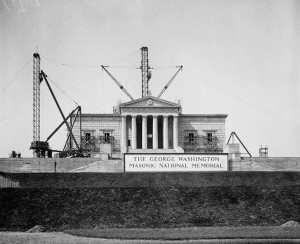 A series of fires in the eighteenth century solidified the need for a fire resistant building to host the lodge’s irreplaceable collection of Washingtonia. Concurrently, while there were numerous celebrations of the Founding Father and first president, there was a growing desire to create a memorial to Washington the Freemason. In 1908, Charles H. Callahan, Alexandria City Commissioner of Revenue and Senior Warden of Alexandria-Washington Lodge (Callahan would later serve as Master of the Lodge from 1910-1911 and Grand Master of Virginia from 1924-1925) proposed that a Masonic memorial be built in Washington’s home of Alexandria. The lodge created a local committee to study the feasibility and later recommended the creation of a national association allowing all American Masons to contribute to the creation of a memorial and museum space to celebrate our Illustrious Brother. In 1915, Alexandria-Washington Lodge purchased a large plot of land on Shuter’s Hill and plans for the scope of the memorial – initially envisioned as a modest two story building budgeted at $10,000 to serve as the permanent home of Alexandria-Washington Lodge and a small museum for its relics – began to grow. As the 1923 groundbreaking approached, the vision was now for a $4 million (in 1923 dollars), 330-foot building constructed entirely of granite and modeled after the Lighthouse of Alexandria, Egypt, one of the Seven Wonders of the Ancient World. The cornerstone was laid on November 1, 1923 in a Masonic ceremony led by Charles Callahan and attended by approximately 14,000 Masons from around the country and dignitaries including President Calvin Coolidge and Chief Justice William Howard Taft. The silver trowel used in the ceremony was the same one employed by George Washington to lay the cornerstone of the U.S. Capitol building in 1793, which he then presented to Alexandria-Washington Lodge and it remains a crown jewel of our archives to this day.
A series of fires in the eighteenth century solidified the need for a fire resistant building to host the lodge’s irreplaceable collection of Washingtonia. Concurrently, while there were numerous celebrations of the Founding Father and first president, there was a growing desire to create a memorial to Washington the Freemason. In 1908, Charles H. Callahan, Alexandria City Commissioner of Revenue and Senior Warden of Alexandria-Washington Lodge (Callahan would later serve as Master of the Lodge from 1910-1911 and Grand Master of Virginia from 1924-1925) proposed that a Masonic memorial be built in Washington’s home of Alexandria. The lodge created a local committee to study the feasibility and later recommended the creation of a national association allowing all American Masons to contribute to the creation of a memorial and museum space to celebrate our Illustrious Brother. In 1915, Alexandria-Washington Lodge purchased a large plot of land on Shuter’s Hill and plans for the scope of the memorial – initially envisioned as a modest two story building budgeted at $10,000 to serve as the permanent home of Alexandria-Washington Lodge and a small museum for its relics – began to grow. As the 1923 groundbreaking approached, the vision was now for a $4 million (in 1923 dollars), 330-foot building constructed entirely of granite and modeled after the Lighthouse of Alexandria, Egypt, one of the Seven Wonders of the Ancient World. The cornerstone was laid on November 1, 1923 in a Masonic ceremony led by Charles Callahan and attended by approximately 14,000 Masons from around the country and dignitaries including President Calvin Coolidge and Chief Justice William Howard Taft. The silver trowel used in the ceremony was the same one employed by George Washington to lay the cornerstone of the U.S. Capitol building in 1793, which he then presented to Alexandria-Washington Lodge and it remains a crown jewel of our archives to this day.
Construction of the memorial proceeded incrementally in the years that followed, as no debt was incurred and new work was undertaken only as the required funds were raised. The first lodge meeting was held in the still-unfinished structure in November 1929, and construction of both the South Lodge Room and Replica Lodge Room were completed in 1942. The Replica Lodge Room is a precise reproduction of the lodge’s meeting space at City Hall and serves as a museum space displaying prized items of Washingtonia from our archives. The neoclassical South Lodge Room became the permanent home of Alexandria-Washington Lodge in 1945 and remains so to this day.



